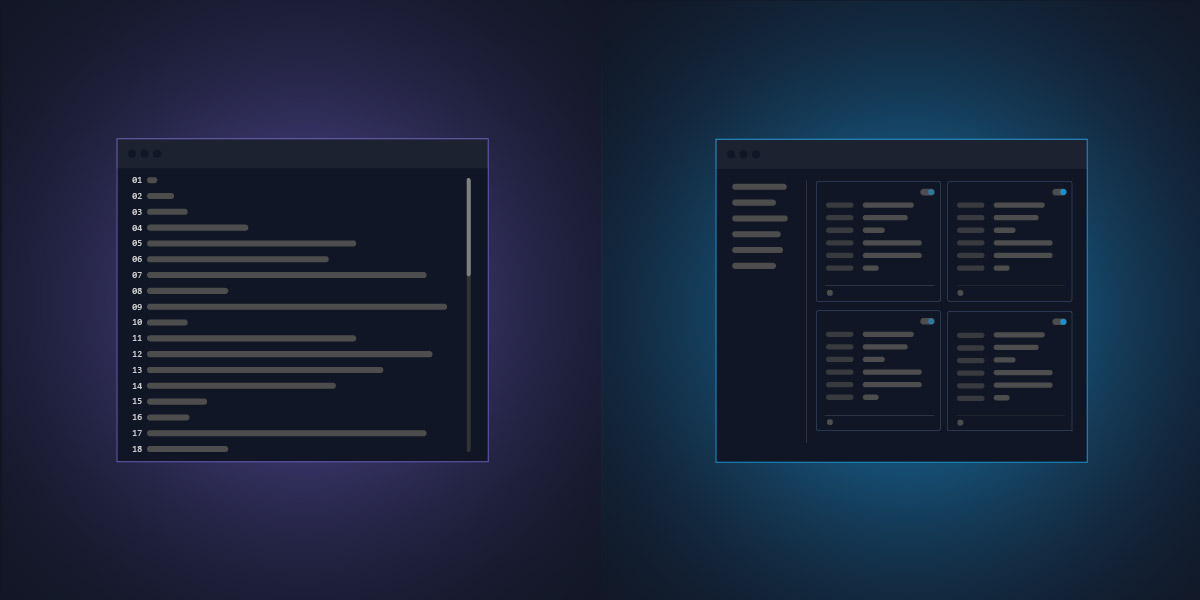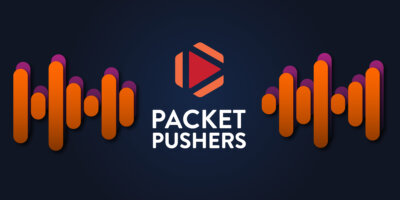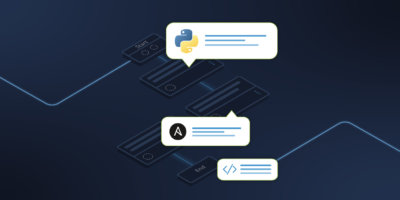No two IT organizations have the same approach to managing and automating network infrastructure. Enterprise networks are comprised of many different device types, services, platforms, and vendor infrastructure. And within the same network team, different skillsets and areas of expertise can mean there are multiple approaches to automation between engineers.
This complexity can make it difficult to scale network automation efforts to match the pace of business. But networks need to continue to accelerate — priorities like rapid application development and security at the cloud are pushing enterprise network teams beyond their capabilities.
The answer? Bridging across this complexity, allowing different tools and methods to exist while centralizing and unifying your automation stack using an orchestration platform.
The best way forward is pairing high-code network automation tooling with low-code orchestration platforms that can maximize automation scripts by providing enterprise-grade integration, data transformation, sharing, and security features.
High-Code Network Automation: Python, Playbooks, & Plans
One of the most important and prevalent network automation strategies is embracing high-code, often open source tooling such as Python, Ansible, and Terraform/OpenTofu. Engineers invest time into learning code and/or YAML to build scripts that automate configuration changes.
Code-driven network automation offers several key advantages:
- It’s flexible, and teams can tailor automation to their specific network environment.
- There’s usually no cost, no budget approvals, and no barrier to adoption or switching tools.
- Building and running scripts allows engineers to keep up with higher network service request volume.
- It saves time and effort by turning networking expertise into reusable code.
But not every network engineer is a coder. And while code-driven automation can be really effective for keeping up with request volumes and automating routine activities, there are some challenges that are tough to overcome:
- It’s difficult to securely share network automation scripts with team members or with other teams.
- It takes time and effort for network engineers to become proficient with Python, Ansible/YAML, or other chosen tools. It also takes time to build and test code.
- As an engineer or team’s library of scripts grows, it becomes more difficult and time-consuming to maintain, and that maintenance will negatively impact productivity.
- While network engineers can build code to automate tasks, orchestrating changes end-to-end across multiple domains is a software development effort that’s outside the scope of what a network team can and should be doing.
The orchestration point is especially crucial. Building custom code to integrate with every system, domain, and platform involved in an end-to-end change process — and manipulate data between steps — is a highly complex project on its own. In addition, systems change, processes change, and there are multiple levels of change across the network over time — requiring robust version control and continuous custom development. Orchestration, especially an orchestration system that’s scalable and extensible to provide real value, is not an automation task — it’s a software development effort that’s not practical to take on for a network automation team.
What’s the answer? Teams need ways to make the most of their high-code automation efforts, getting the most use out of each script by enabling secure sharing and helping engineers avoid falling into code maintenance and management spirals and losing all their time.
How can teams extend the impact of a high-code strategy and continue to benefit from its unique advantages while scaling and accelerating with orchestration?
Low-Code, API-Driven Orchestration Platforms
Most network teams may roll their eyes when they hear “low-code.” However, low-code is more than just a synonym for GUI. With the right low-code orchestration platform, teams and organizations can see transformative benefits and reach another level of efficiency compared to a high-code-only approach.
That’s what the Itential Automation Platform is so good at. We offer integration, data transformation, and orchestration capabilities with a low-code workflow interface, but at the same time, high-code automation assets like Python scripts are treated as first-class citizens. Engineers can onboard their scripts, attach APIs to them, and incorporate them into an orchestrated workflow to drive efficiency and get the most out of what they’ve built.
That means every portion of service delivery — from ticket creation to fulfillment — can be automated, using both high-code assets built by the team and low-code orchestration and integration capabilities provided by the Itential platform.
So, in a network team where engineers are proficient with automation, building scripts to push config to various devices across the network, Itential can extend the impact of automation and deliver transformative efficiency gains. The platform can:
- Allow network engineers without coding expertise to build workflows, Golden Configuration templates, command templates, JSON forms, and other modular and reusable automation assets.
- Enhance sharing with RBAC, security platform integration, and northbound API exposure to enable self-serve networking.
- Automatically integrate with systems of record, security platforms, and ITSM/change management platforms such as ServiceNow to eliminate difficult, time-consuming custom development.
- Improve standardization of processes and ensure every change includes compliance and validation steps in the workflow.
- Accelerate network service delivery across the business far beyond what teams can achieve with DIY alone.
We’re all about accelerating network teams by providing the best environment for automation and orchestration — no matter your skillset or tool preference. Teams want to expand their automation reach, they’ve embraced high-code tooling, and they’ve seen significant progress there. We’re aiming to meet teams where they are, giving them the tools to do more with what they build, and enabling more advanced approaches like zero-touch, end-to-end orchestration and self-service delivery that would not be possible with DIY alone.
Real-World Example: How Fiserv Embraced Both High-Code & Low Code for Success
Connecting a high-code strategy with low-code orchestration is exactly how Fiserv leveled up their automation practice — as explained by Network Automation & Architecture Director Michael Wynston for Packet Pushers in this podcast episode.
One of their early moves was a team-wide investment in training Python and Ansible skills across multiple network teams. They hired outside consultants to lead the training, and in terms of upskilling, it went well. The engineers picked up new code skills successfully. However, because of a disconnect between the chosen use cases and the realities of the network team on the ground, automation adoption was low. Once the consultants left, the team didn’t really pick up speed, instead returning to some of their previous techniques for managing the network.
After all, as Michael said in the podcast, “engineers don’t need a lot of help pushing config.” They didn’t stand to gain much by leveraging high-code tooling to automate config pushes alone. They had to widen their view.
When they identified the key time sink — interacting with systems of record to be able to make network changes — they were able to better choose what tooling they needed. They would continue developing high-code automation scripts for config pushes, but they would coordinate those scripts with automated interactions with systems of record using Itential’s integration capabilities in a low-code workflow.
Fiserv was able to bring low-code and high-code together, lowering the barrier to entry for automation across their organization and enabling the secure delivery of orchestrated workflows for developers and other internal end users to self-serve. They’ve been able to accelerate and gain more confidence in automation while simultaneously expanding its reach and allowing the entire network team to become more productive.
To find network automation and orchestration success, your teams should embrace high-code automation while also recognizing the value of low-code orchestration. It’s about using everything at your disposal to maximize team productivity and deliver the most efficient network possible for the business.





